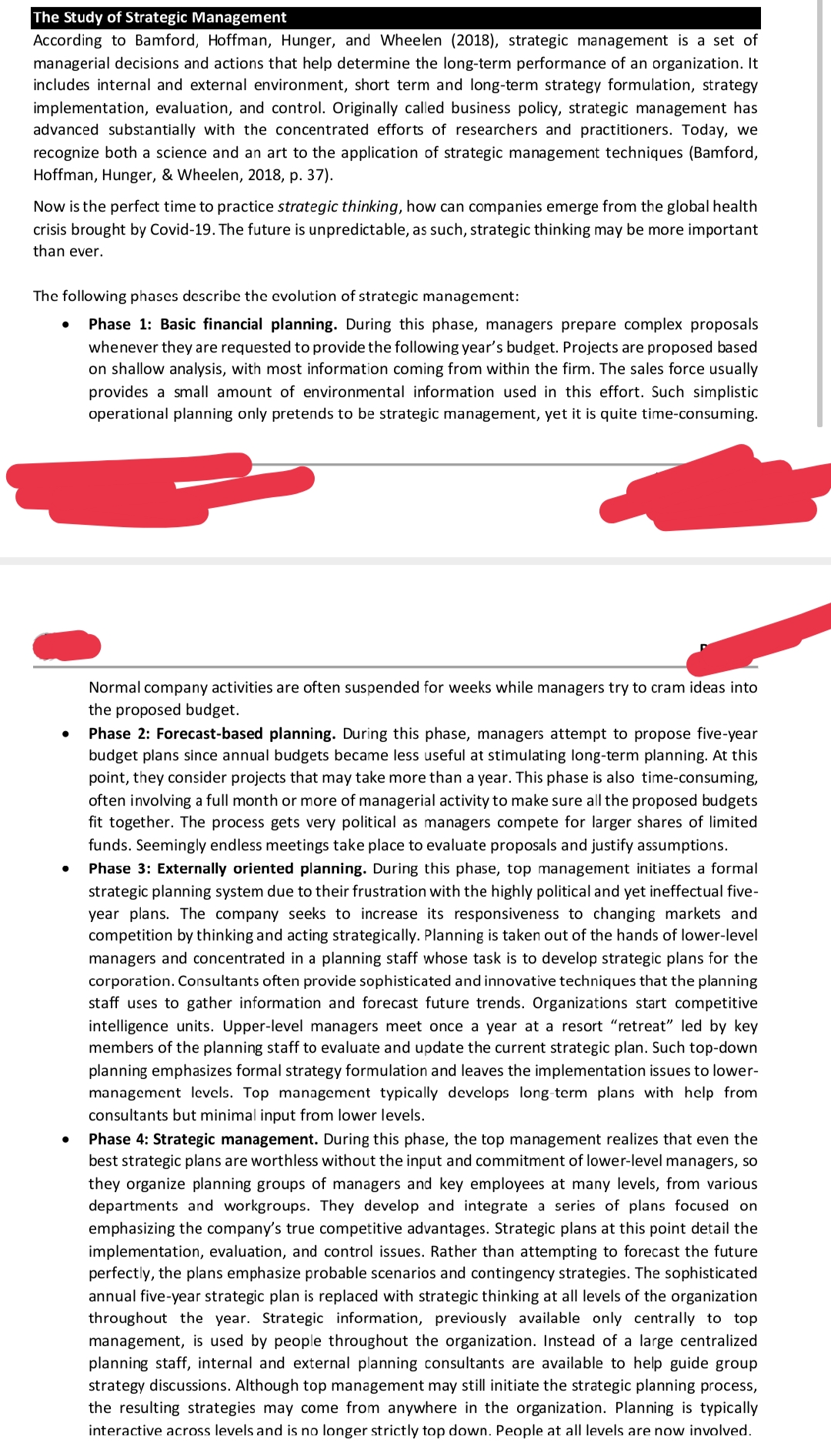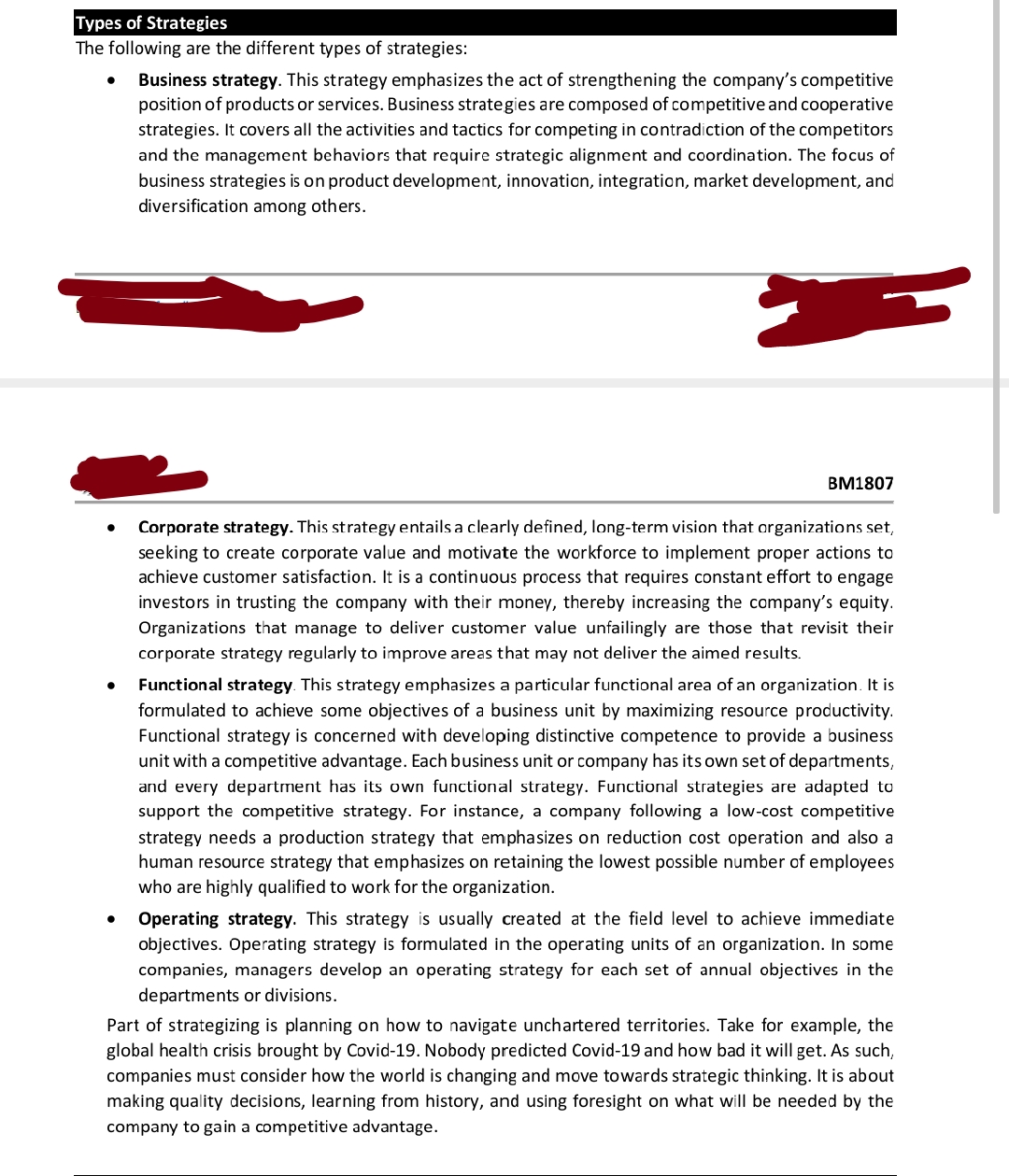competition by thinking and acting strategically. Planning is taken out of the hands of lower-level managers and concentrated in a planning staff whose task is to develop strategic plans for the corporation. Consultants often provide sophisticated and innovative techniques that the planning staff uses to gather information and forecast future trends. Organizations start competitive intelligence units. Upper-level managers meet once a year at a resort "retreat" led by key members of the planning staff to evaluate and update the current strategic plan. Such top-down planning emphasizes formal strategy formulation and leaves the implementation issues to lower- management levels. Top management typically develops long-term plans with help from consultants but minimal input from lower levels. Phase 4: Strategic management. During this phase, the top management realizes that even the best strategic plans are worthless without the innut and commitment of lower-level managers so
competition by thinking and acting strategically. Planning is taken out of the hands of lower-level managers and concentrated in a planning staff whose task is to develop strategic plans for the corporation. Consultants often provide sophisticated and innovative techniques that the planning staff uses to gather information and forecast future trends. Organizations start competitive intelligence units. Upper-level managers meet once a year at a resort "retreat" led by key members of the planning staff to evaluate and update the current strategic plan. Such top-down planning emphasizes formal strategy formulation and leaves the implementation issues to lower- management levels. Top management typically develops long-term plans with help from consultants but minimal input from lower levels. Phase 4: Strategic management. During this phase, the top management realizes that even the best strategic plans are worthless without the innut and commitment of lower-level managers so
Principles Of Marketing
17th Edition
ISBN:9780134492513
Author:Kotler, Philip, Armstrong, Gary (gary M.)
Publisher:Kotler, Philip, Armstrong, Gary (gary M.)
Chapter1: Marketing: Creating Customer Value And Engagement
Section: Chapter Questions
Problem 1.1DQ
Related questions
Question

Transcribed Image Text:The Study of Strategic Management
According to Bamford, Hoffman, Hunger, and Wheelen (2018), strategic management is a set of
managerial decisions and actions that help determine the long-term performance of an organization. It
includes internal and external environment, short term and long-term strategy formulation, strategy
implementation, evaluation, and control. Originally called business policy, strategic management has
advanced substantially with the concentrated efforts of researchers and practitioners. Today, we
recognize both a science and an art to the application of strategic management techniques (Bamford,
Hoffman, Hunger, & Wheelen, 2018, p. 37).
Now is the perfect time to practice strategic thinking, how can companies emerge from the global health
crisis brought by Covid-19. The future is unpredictable, as such, strategic thinking may be more important
than ever.
The following phases describe the evolution of strategic management:
Phase 1: Basic financial planning. During this phase, managers prepare complex proposals
whenever they are requested to provide the following year's budget. Projects are proposed based
on shallow analysis, with most information coming from within the firm. The sales force usually
provides a small amount of environmental information used in this effort. Such simplistic
operational planning only pretends to be strategic management, yet it is quite time-consuming.
Normal company activities are often suspended for weeks while managers try to cram ideas into
the proposed budget.
Phase 2: Forecast-based planning. During this phase, managers attempt to propose five-year
budget plans since annual budgets became less useful at stimulating long-term planning. At this
point, they consider projects that may take more than a year. This phase is also time-consuming,
often involving a full month or more of managerial activity to make sure all the proposed budgets
fit together. The process gets very political as managers compete for larger shares of limited
funds. Seemingly endless meetings take place to evaluate proposals and justify assumptions.
Phase 3: Externally oriented planning. During this phase, top management initiates a formal
strategic planning system due to their frustration with the highly political and yet ineffectual five-
year plans. The company seeks to increase its responsiveness to changing markets and
competition by thinking and acting strategically. Planning is taken out of the hands of lower-level
managers and concentrated in a planning staff whose task is to develop strategic plans for the
corporation. Consultants often provide sophisticated and innovative techniques that the planning
staff uses to gather information and forecast future trends. Organizations start competitive
intelligence units. Upper-level managers meet once a year at a resort "retreat" led by key
members of the planning staff to evaluate and update the current strategic plan. Such top-down
planning emphasizes formal strategy formulation and leaves the implementation issues to lower-
management levels. Top management typically develops long-term plans with help from
consultants but minimal input from lower levels.
Phase 4: Strategic management. During this phase, the top management realizes that even the
best strategic plans are worthless without the input and commitment of lower-level managers, so
they organize planning groups of managers and key employees at many levels, from various
departments and workgroups. They develop and integrate a series of plans focused on
emphasizing the company's true competitive advantages. Strategic plans at this point detail the
implementation, evaluation, and control issues. Rather than attempting to forecast the future
perfectly, the plans emphasize probable scenarios and contingency strategies. The sophisticated
annual five-year strategic plan is replaced with strategic thinking at all levels of the organization
throughout the year. Strategic information, previously available only centrally to top
management, is used by people throughout the organization. Instead of a large centralized
planning staff, internal and external planning consultants are available to help guide group
strategy discussions. Although top management may still initiate the strategic planning process,
the resulting strategies may come from anywhere in the organization. Planning is typically
interactive across levels and is no longer strictly top down. People at all levels are now involved.

Transcribed Image Text:Types of Strategies
The following are the different types of strategies:
Business strategy. This strategy emphasizes the act of strengthening the company's competitive
position of products or services. Business strategies are composed of competitive and cooperative
strategies. It covers all the activities and tactics for competing in contradiction of the competitors
and the management behaviors that require strategic alignment and coordination. The focus of
business strategies is on product development, innovation, integration, market development, and
diversification among others.
BM1807
Corporate strategy. This strategy entails a clearly defined, long-term vision that organizations set,
seeking to create corporate value and motivate the workforce to implement proper actions to
achieve customer satisfaction. It is a continuous process that requires constant effort to engage
investors in trusting the company with their money, thereby increasing the company's equity.
Organizations that manage to deliver customer value unfailingly are those that revisit their
corporate strategy regularly to improve areas that may not deliver the aimed results.
Functional strategy. This strategy emphasizes a particular functional area of an organization. It is
formulated to achieve some objectives of a business unit by maximizing resource productivity.
Functional strategy is concerned with developing distinctive competence to provide a business
unit with a competitive advantage. Each business unit or company has its own set of departments,
and every department has its own functional strategy. Functional strategies are adapted to
support the competitive strategy. For instance, a company following a low-cost competitive
strategy needs a production strategy that emphasizes on reduction cost operation and also a
human resource strategy that emphasizes on retaining the lowest possible number of employees
who are highly qualified to work for the organization.
Operating strategy. This strategy is usually created at the field level to achieve immediate
objectives. Operating strategy is formulated in the operating units of an organization. In some
companies, managers develop an operating strategy for each set of annual objectives in the
departments or divisions.
Part of strategizing is planning on how to navigate unchartered territories. Take for example, the
global health crisis brought by Covid-19. Nobody predicted Covid-19 and how bad it will get. As such,
companies must consider how the world is changing and move towards strategic thinking. It is about
making quality decisions, learning from history, and using foresight on what will be needed by the
company to gain a competitive advantage.
Expert Solution
This question has been solved!
Explore an expertly crafted, step-by-step solution for a thorough understanding of key concepts.
Step by step
Solved in 3 steps

Recommended textbooks for you

Principles Of Marketing
Marketing
ISBN:
9780134492513
Author:
Kotler, Philip, Armstrong, Gary (gary M.)
Publisher:
Pearson Higher Education,

Marketing
Marketing
ISBN:
9781259924040
Author:
Roger A. Kerin, Steven W. Hartley
Publisher:
McGraw-Hill Education

Foundations of Business (MindTap Course List)
Marketing
ISBN:
9781337386920
Author:
William M. Pride, Robert J. Hughes, Jack R. Kapoor
Publisher:
Cengage Learning

Principles Of Marketing
Marketing
ISBN:
9780134492513
Author:
Kotler, Philip, Armstrong, Gary (gary M.)
Publisher:
Pearson Higher Education,

Marketing
Marketing
ISBN:
9781259924040
Author:
Roger A. Kerin, Steven W. Hartley
Publisher:
McGraw-Hill Education

Foundations of Business (MindTap Course List)
Marketing
ISBN:
9781337386920
Author:
William M. Pride, Robert J. Hughes, Jack R. Kapoor
Publisher:
Cengage Learning

Marketing: An Introduction (13th Edition)
Marketing
ISBN:
9780134149530
Author:
Gary Armstrong, Philip Kotler
Publisher:
PEARSON


Contemporary Marketing
Marketing
ISBN:
9780357033777
Author:
Louis E. Boone, David L. Kurtz
Publisher:
Cengage Learning